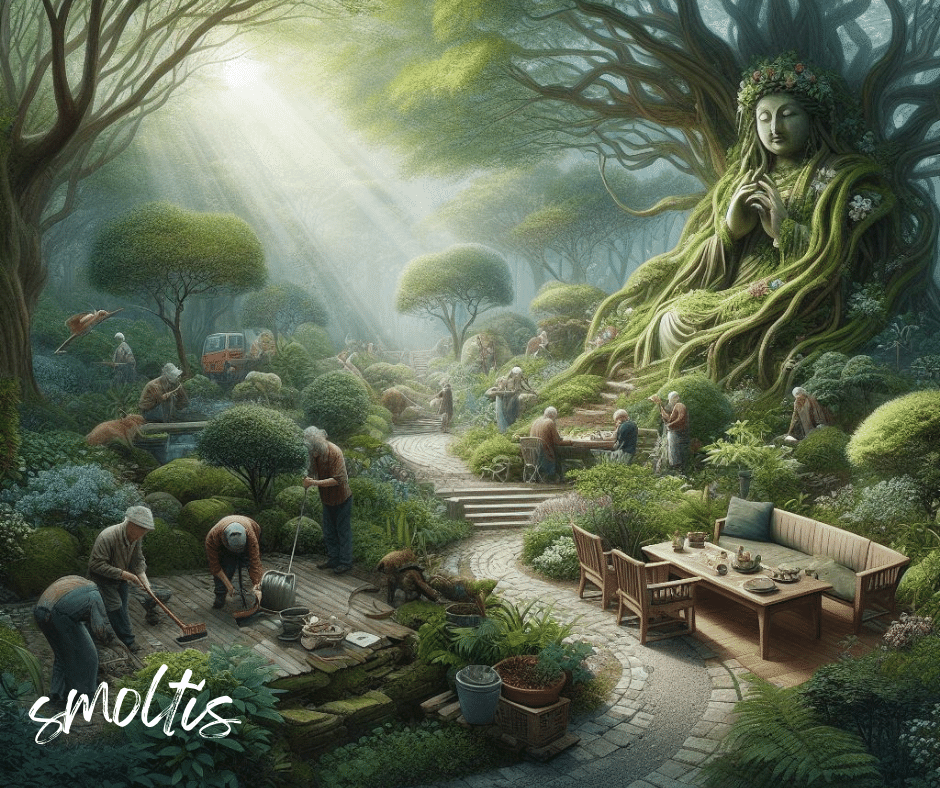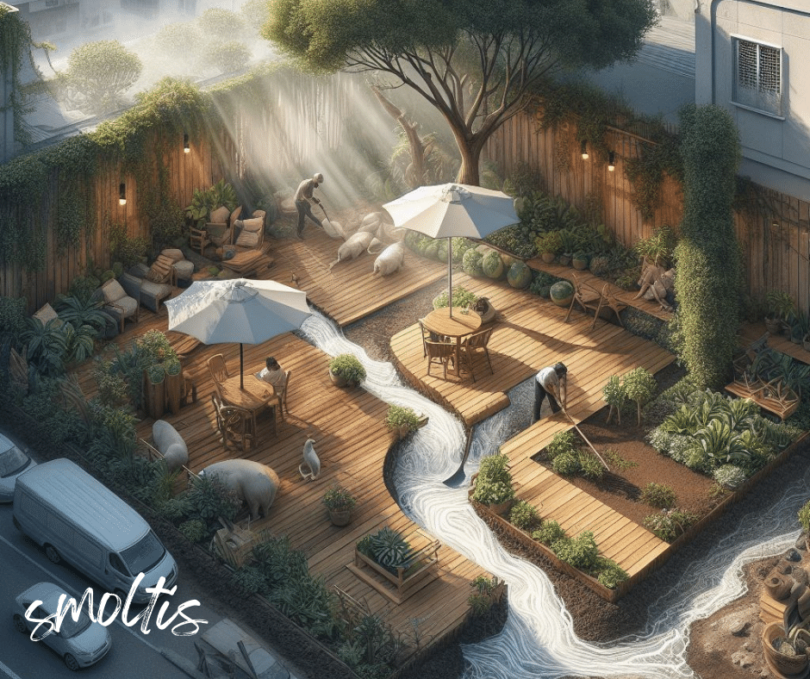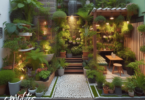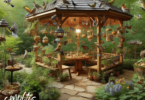Transforming neglected shady garden spaces into inviting and vibrant retreats can breathe new life into your outdoor areas. These gloomy corners, often overlooked, have immense potential to become havens of relaxation and beauty. By exploring creative outdoor shade solutions, landscaping techniques for shade, and careful garden design, you can revitalize these forgotten areas and create functional and visually appealing shady retreats.

Key Takeaways:
- Shady garden spaces, if neglected, can be transformed into stunning retreats with the right approach.
- Outdoor shade solutions, such as shade canopies and pergolas, can enhance the usability and aesthetic of shady areas.
- Landscaping techniques specifically designed for shade can optimize the natural beauty of your garden.
- Creative garden design and the use of shade-loving plants can create lush and inviting atmospheres.
- Assessing the amount of shade present in your garden and understanding its impact is crucial for effective renovation.
Assessing Your Shady Garden Space
Before embarking on your renovation project, it is crucial to assess the condition of your shady garden space. Understanding the unique characteristics of these areas will help you plan your garden design effectively and create a thriving oasis. Consider the following factors:
1. Garden Design for Shade
When designing a garden for shade, it’s important to focus on creating a harmonious and balanced atmosphere. Incorporate elements such as different plant heights, textures, and colors to add depth and visual interest to your space. By carefully selecting and arranging shade-loving plants, you can transform your shady garden into a lush and vibrant retreat.
2. Shade-Loving Plants
When selecting plants for your shady garden, opt for species that thrive in low-light conditions. These shade-loving plants are adapted to survive and flourish in environments with limited direct sunlight. Some popular options include:
- Ferns: Known for their elegant foliage, ferns are excellent choices for shady areas. They add a touch of freshness and grace to any garden.
- Hostas: With their vibrant and variegated leaves, hostas are versatile and low-maintenance plants that thrive in shade.
- Astilbes: These beautiful, feathery flowers bring vibrant colors to shady spots and flourish in moist soil.
- Heucheras: Offering a wide range of foliage colors, heucheras add visual interest and create stunning contrasts in shady gardens.
3. Evaluating Shade Levels
Assessing the amount of shade present in different areas of your garden is essential for determining which types of plants will thrive. Evaluate the level of shade by observing the amount of sunlight reaching the space at different times of the day. Shade can vary from partial to full, and certain plants have specific requirements regarding the amount of sunlight they need to grow healthily.
“Understanding the shade levels in your garden will help you choose plants that are best suited to the conditions and create a thriving, shade-filled oasis.”
4. Assessing Shade Impact
In addition to evaluating the amount of shade, it’s crucial to assess how shade impacts different areas of your garden. Consider the following:
- Watering: Shady areas tend to retain more moisture, so be mindful of the watering needs of your plants to prevent overwatering.
- Soil Quality: Shady areas may have different soil conditions, such as increased acidity or moisture. Test your soil and make any necessary amendments to ensure optimal plant growth.
- Foot Traffic: Determine how shade affects the foot traffic in your garden and plan pathways accordingly to prevent excessive wear and tear on certain areas.
5. Mapping Your Garden
To better understand your shady garden space, create a map of your garden, marking the areas of shade and sunlight as well as any existing structures or features. This map will serve as a valuable reference point when planning and implementing your garden renovation.
With a clear understanding of your shady garden space and the principles of garden design for shade, you can confidently embark on your renovation project. By carefully selecting shade-loving plants and considering the impact of shade on different areas, you will create a lush and inviting sanctuary.
| Shade-Loving Plants | Height | Sunlight Requirements | Soil Conditions |
|---|---|---|---|
| Ferns | Varies | Partial Shade | Moist, Well-Drained |
| Hostas | Varies | Partial to Full Shade | Moist, Well-Drained |
| Astilbes | 18-36 inches | Partial Shade to Full Shade | Moist, Well-Drained |
| Heucheras | 6-18 inches | Partial Shade to Full Shade | Moist, Well-Drained |
Designing Shady Retreats
Transforming neglected areas into inviting retreats requires thoughtful and creative garden design. In this section, we will explore various shady backyard ideas to inspire your renovation project. Discover how to incorporate shade-loving plants into your design to achieve a lush and vibrant atmosphere. Learn about different elements, such as paths, seating areas, and water features, that can enhance your shady retreats.
When it comes to designing shady retreats, there are endless possibilities to transform your neglected garden spaces into beautiful havens. Here are some ideas to inspire your renovation project:
- Create a Zen Garden: Utilize low-maintenance shade-loving plants like ferns, hostas, and moss to create a soothing and peaceful atmosphere.
- Install a Pergola: Add architectural interest to your garden with a pergola covered in climbing plants like wisteria or jasmine. This provides both shade and an enchanting visual element.
- Design a Secret Garden: Incorporate winding paths, archways covered in climbers, and secluded seating areas surrounded by shade-loving perennials for a whimsical and secluded atmosphere.
- Introduce Water Features: Enhance the tranquility of your shady retreat by incorporating water features like a small pond, birdbath, or fountain. These will not only attract wildlife but also provide a soothing ambiance.
To create a cohesive and visually appealing design, consider the following tips:
Choose a color palette that complements the shade-loving plants you have selected. Opt for cool hues like blues, purples, and whites to create a serene and calming atmosphere.
Incorporate different textures and heights to add depth and interest to your shady retreat. Combine plants with varying leaf shapes and sizes, and consider incorporating taller plants or trees to create a layered effect.
Remember to also consider the practical aspects of your design. Ensure there is enough space for comfortable seating and easy access to paths or seating areas. Additionally, provide sufficient lighting for evening enjoyment of your shady retreat.
By implementing these shady backyard ideas and paying attention to the specific needs of shade-loving plants, you can design a stunning and inviting space that will become your favorite spot to unwind and relax.
Implementing Outdoor Shade Solutions
To fully embrace your renovated shady garden, it’s essential to implement a range of outdoor shade solutions. In this section, we will explore various options for providing adequate shade, including shade canopies, pergolas, and umbrellas. Understanding the benefits and considerations of each option will help you choose the perfect shade solution for your garden.
Shade Canopies
Shade canopies are versatile outdoor shade solutions that offer both protection from the sun and a stylish addition to your garden. These canopies come in various shapes and sizes, ranging from retractable options to permanent installations. They can be attached to structures like your house or freestanding in your garden.
Transform your garden into an oasis of comfort with a shade canopy that not only provides shelter but also adds an elegant touch to your outdoor space.
Pergolas
A pergola is a structure that provides partial shade by supporting climbing plants such as vines or roses. These timeless outdoor retreats create a natural and inviting atmosphere in your garden. Pergolas come in a variety of materials, including wood, metal, and vinyl, allowing you to choose one that complements your garden’s style.
Umbrellas
If you prefer a more flexible shade solution, umbrellas are a popular choice. They are portable and can be moved around your garden to provide shade exactly where you need it. Umbrellas come in a wide range of sizes, colors, and styles, allowing you to find one that suits your taste and garden aesthetic.
When selecting outdoor shade solutions, consider factors such as the size of your garden, the desired level of protection, and your budget. Each option has its own advantages and considerations, so take the time to evaluate which shade solution best fits your needs.
Landscaping Techniques for Shade
Proper landscaping techniques are crucial when it comes to creating beautiful and functional shady retreats. By implementing the right strategies, you can transform your shady garden spaces into inviting havens of tranquility. Let’s explore some key landscaping techniques that will help you optimize the natural shade in your garden.
Soil Preparation
Before planting shade-loving plants, it’s essential to prepare the soil properly. Landscaping for shade requires soil that is rich in organic matter, well-draining, and able to retain moisture. Incorporate compost or organic matter into the soil to improve its fertility, structure, and ability to retain water. By creating a nutrient-rich foundation, you provide the necessary conditions for your shade-loving plants to thrive.
Proper Planting Techniques
When planting in shady areas, it’s important to consider the specific needs of shade-loving plants. Creating shady retreats involves selecting the right plants for the level of shade in your garden. Planting techniques such as providing ample spacing between plants, digging proper-sized holes, and watering thoroughly after planting are critical for the successful establishment of shade-loving plants. These techniques ensure that the plants have enough room to grow, receive adequate water, and can fully benefit from the available shade.
Selecting the Right Plants
The key to creating thriving shady retreats is choosing the right plants that thrive in low light conditions. Shade-loving plants are adapted to grow in areas with limited sun exposure. Some popular shade-loving plants include hostas, ferns, hydrangeas, and impatiens. Consider the specific light requirements, water needs, and growth characteristics of these plants when selecting them for your shady garden spaces. By carefully choosing shade-loving plants, you can create a harmonious and visually appealing atmosphere that flourishes even in the darkest corners of your garden.
By implementing proper landscaping techniques tailored to shade, you can transform neglected shady areas into lush and inviting retreats. The combination of soil preparation, proper planting techniques, and the selection of shade-loving plants will optimize the natural shade in your garden and create a serene oasis for relaxation and enjoyment.
Conclusion
In conclusion, renovating neglected shady garden spaces can breathe new life into your outdoor areas. By assessing your space, designing thoughtful retreats, implementing outdoor shade solutions, and utilizing landscaping techniques for shade, you can create lush sanctuaries that are both functional and visually appealing.
Start by assessing the amount of shade present and its impact on different areas of your garden. This will help you determine the best approach for your renovation project. Then, incorporate shade-loving plants into your design to achieve a vibrant atmosphere. Consider elements like paths, seating areas, and water features to enhance your shady retreats.
Implementing outdoor shade solutions is crucial to fully enjoy your renovated space. Explore different options such as shade canopies, pergolas, and umbrellas, and choose the one that best suits your garden and personal preferences. Lastly, utilize landscaping techniques specifically designed for shade. Preparing the soil, selecting the right plants, and employing proper planting techniques will ensure a harmonious and visually appealing atmosphere.
Embrace the beauty of shade and transform your gloomy corners into inviting havens for relaxation and enjoyment. With careful planning and attention to detail, your renovated shady garden spaces will become rejuvenating sanctuaries where you can escape the sun and reconnect with nature.
FAQ
Why should I revive neglected shady garden spaces?
Reviving neglected shady garden spaces can completely transform your outdoor areas. These gloomy corners can be converted into beautiful and functional retreats where you can relax and enjoy nature. By breathing new life into these spaces, you can add value to your property and create inviting spots for outdoor entertaining.
What are some outdoor shade solutions I can use in my garden?
There are several outdoor shade solutions you can consider for your garden. Shade canopies, pergolas, and umbrellas are popular options that provide protection from the sun and create a comfortable environment. These structures can also add visual interest and enhance the overall design of your garden.
How can I design my shady garden space?
Designing a shady garden space requires careful planning and consideration. Incorporate shade-loving plants into your design to create a lush and vibrant atmosphere. Introduce elements such as paths, seating areas, and water features to enhance the overall appeal of your shady retreat. Pay attention to the layout and arrangement of plants to maximize the use of space and create an inviting environment.
What are some shady backyard ideas I can explore?
There are numerous shady backyard ideas that can inspire your renovation project. Consider creating a cozy seating area under a tree canopy, installing a charming garden bench in a shaded nook, or designing a small pond surrounded by shade-loving plants. These ideas can help you transform neglected areas into inviting retreats.
What landscaping techniques are suitable for shade?
When landscaping for shade, it is important to focus on soil preparation, proper planting techniques, and selecting the right shade-loving plants. Create a well-drained soil by adding organic matter and ensure proper irrigation. Plant shade-tolerant varieties and arrange them according to their sunlight requirements. Consider layering plants of different heights to create visual interest and optimize the natural shade in your garden.







